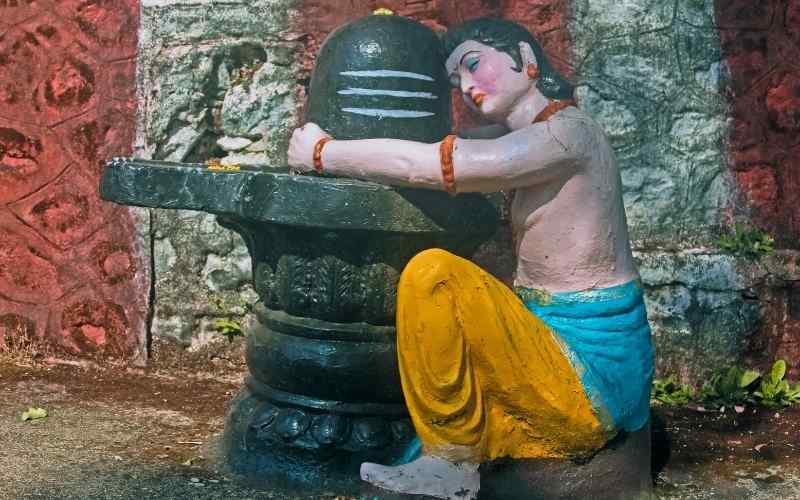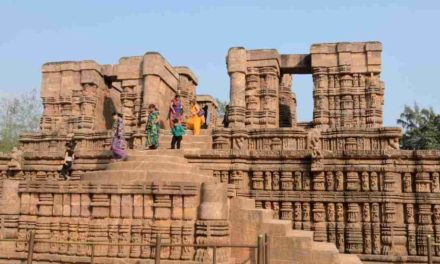Understanding Advaita Vedanta it is important to consider the simple point that we often live our lives in an unexamined manner, and therefore we work with definitions that are not clearly delineated by the ‘edges.’ Find the word that, in Vedantic debates, is absolutely fundamental – truth.
“Non-duality” is the name given to a school of Hindu philosophy that was originally known as Puruavda. It is considered to be a classic system of spiritual enlightenment in Indian tradition and is translated as “non-duality.”
The name Advaita refers to the belief that the genuine self, Atman, is the same as the ultimate metaphysical fact of the cosmos, Brahman, which is the highest metaphysical reality of all.
The Advaita Vedanta school of thought may be traced back to the earliest Upanishads. It is based on three literary sources together known as the Prasthanatrayi. It provides “a comprehensive explanation of the whole corpus of Upanishads,” as well as the Brahma Sutras and the Bhagavad Gita, among other things.
Advaita Vedanta is the oldest surviving sub-school of Vedanta, which is one of the six orthodox (stika) Hindu philosophies (darana), and it is the most recent of the six orthodox schools of Vedanta.
In spite of the fact that its origins date back to the first millennium BCE, the Advaita Vedanta is generally thought to have been popularized by the 8th-century philosopher Adi Shankara, according to traditional accounts.
When it comes to moksha (freedom and liberation), Advaita Vedanta stresses Jivanmukti, the belief that moksha (liberation and freedom) is accessible in this life, as opposed to other Indian philosophies that emphasize videhamukti, or moksha after death.
When it comes to its conceptions of moksha, the school draws on principles found in major Indian religious traditions like Brahman, Atman, Maya, Avidya, meditation, and others, but it interprets them in a manner that is unique to the school.
Advaita Vedanta is one of the most researched and prominent schools of traditional Indian thinking, and it has been around for thousands of years. Many academics characterize Advaita philosophy as a sort of monism, while others describe it as a non-dualistic form of philosophy. The philosophy of Advaita is regarded to be more of a spiritual road than religion since it does not require individuals who follow it to be members of a specific faith or denomination.
Many other Hindu traditions and writings, including those of Samkhya, Yoga, Nyaya, and other sub-schools of Vedantism as well as the Puranas and the Agamas, as well as social movements such as those of the Bhakti movement, had an impact on and were affected by Advaita. Other Indian traditions such as Jainism and Buddhism engaged with and influenced Advaita Vedanta’s development, which extended beyond Hinduism.
The scriptures of Advaita Vedanta include a range of viewpoints ranging from idealism, including illusionism, through realism or virtually realist attitudes articulated in the early works of Shankara, among others. In current times, its teachings may be found in a variety of Neo-Vedanta groups. It has been referred to as the “paradigm” of Hindu spirituality because of its universal appeal.
For a rough and ready notion of what constitutes as ‘true’, we pass along our diverse social circuits: we consider computers, human beings, and chairs as actual, and unicorns, phlogistons, and goblins as imaginary. In reality, those meanings represent us well in much of our everyday contexts.
Vedanta refers to the latter portions of the Vedas, which embody the essence of the Vedas. The ‘end’ element of the sentence should be interpreted metaphorically here rather than literally. Since the Vedas teach that there is only one supreme reality, the path of Advaita Vedanta might be described as such (non-dual) This is a Brahman.
Philosophy is not what Vedanta is. It’s not a way of thinking. A set of beliefs that cannot be refuted from many perspectives. This isn’t a list of disagreements.
Your opinions about it have no effect on it. Whether or not one vocally acknowledges one’s existence has no effect on how one’s existence persists.
Systematic and organized knowledge, such as Vedanta, allows you to see the whole of reality as you are. Merely said, a means to the goal (moksha/self-realization) is what we call a method of knowledge.
In further detail, the approach discloses the ever-present truth about the self (jiva), the world (Jagat), and existence-consciousness (vara/Brahman) itself. A demonstration of your self-awareness at this particular moment (tat tvam asi).
As long as we’re ignorant, we’ll keep looking for “THE reality” as if it were something different from who we are. This inspires a person to do a variety of acts with the goal of uncovering a greater truth. Because it doesn’t deliver long-term happiness, but rather short-term respite, it frustrates many people.
When it comes to spirituality, it’s like a wooden chair meditating for years in order to find the ultimate Reality. In reality, the chair is nothing more than a piece of lumber.
An honest seeker of knowledge will never become the sought since the seeker is already the sought. It’s up to you to figure out how this works. Vedanta, on the other hand, aims to end this debate once and for all.
In respect to ideas that appear to occupy a type of ‘intermediate’ region between fact and unreality, however, things get hazier. For somebody could argue that we don’t see or perceive or experience human rights in the same direct way that we can visually identify or recognize the people who populate the world.
If a human rights skeptic or activist drives us to the wall that way, we will understand that our natural, and somewhat ambiguous, interpretations of truth will no longer serve us, and what we need is a standard showing which is true and which is imaginary.
The Advaita Vedanta philosophy essentially derives its ‘concept’ of truth from the Upanishads, which relate to Brahman as the unchanging, eternal, and unchanging foundation behind all the empirical shifts we experience.
That is if you were to ask an Advaitin (a practitioner of the Advaita tradition) questions like: ‘What’s binding together the different things I see around me? ‘, ‘Why don’t many items break off in a million directions across my visual field?
‘And’ Why am I living in a world where only certain elements experience transition on a broader backdrop of relative stability? ‘The response is:’ Brahman is the fixed point in our moving universe, the unchanging basis on which all scientific mechanisms are centered, and the unchanging truth that maintains all transient things.
Through Advaita is meant Brahman’s non-duality, or better, Brahman’s rejection of duality. Vedanta darśana’s core idea is that Brahman is the true source of the World and absolute Truth. Both of Vedanta’s schools — dualistic as well as non-dualistic— embrace this.
What’s the gap between Dvaita and Advaita, then? One basic distinction is that individuality is actual according to dualistic classes, and survives even in the Mukti state, while individuality is imaginary in Advaita and does not exist in the Mukti state.
Shankara says: ‘That which is called jiva is not very distinct from Brahman. Brahman himself comes to be called “doer” and “experiencer,” being conditioned by adjuncts such as buddhi, intellect, and the like.
The distinction between the person and the supreme Self is due to the existence of restricting adjuncts, such as the body, formed by names and forms and produced by avidyā; there is no distinction, in reality, this is the understanding Advaita Vedanta.
When the Atman interacts with mind and body, they call it jiva. This identification disappears in the state of Mukti, but the Atman remains distinct and separate from Brahman although it becomes almost similar to Brahman.
Here the Atman-Brahman relationship is an organic relationship, like that, between the part and the whole. Known as svagata-bheda is the form of disparity that occurs between Brahman and the individual self.
Advaita at Brahman rejects svagata-bheda. According to Advaita, the Atman doesn’t remain distinct from Brahman in the condition of Mukti but becomes one with it. In reality, there is no difference between Atman and Brahman; the differentiation between Atman and Brahman always disappears as long as the connection of mind and body disappears. While Advaitins interchangeably use the words Atman and Brahman.
The critical theological-experiential interpretation of the ineffability of Brahman is as follows. Although certain human beings that ‘penultimately’ attain Brahman through the idols or representations of religious worship (say, Rama or Vishnu or Krishna), the devotee itself is ‘ultimately’ or Real-ly Advaita with Brahman above all definitions.
That is if a devotee feels she is significantly different from Brahman, the mistaken opinion, according to Samkara, is a Maya result. Just as pots are not an ‘extra’ category beyond the clay group, the devotees in the different theistic sources of ‘Hinduism’ are not an ‘extra’ category beyond and above Brahman.
Whoever a devotee is, she is Advaita with Brahman in its truest, darkest, and absolute form. Likewise, you-whoever you might be-are Brahman’s Advaita. And when you’re ‘targeting’ Brahman as ‘over there and you’re ‘targeting’ yourself as ‘in here’ this distinction is out of ignorance.
More specifically, what you are ultimately is not the mixture of physical appearances, distinguishing attributes, and sociological identifiers that grants you (and much more) a passport and a driving license; you are fundamentally the divine self (Atman), and this nature is Advaita to Brahman.
There is one and no second. Yet it is the avidya the self that rests in Atman and relies on it. The presence of avidya is deduced from the common understanding conveyed by declarations such as “I am unaware,” “I do not recognize myself,” etc. Falling under avidya’s influence, Atman is lost, as it were, to the eternal beauty and wisdom inherent in it. And it falls victim to relentless tribulations.
The jiva finds what is not the Greatest Good of Creation under the influence of avidya to be the Only Good wished for by all. Thus the individual atman is unable to experience Liberation (Moksha).
Which is truly the Highest Good, falls into the ocean of samsara [the relative world; the unceasing round of births and deaths] and wanders about — assuming the bodies of gods (devas), men, animals, or birds — pursued by the sharks of malice, wrath, and passion. It will, by accident, conduct any meritorious behavior in the course of this wandering and be born as a brahmin or any equivalent human being entitled to Brahman’s Awareness.
Then, it surrenders the outcome to God as it takes behavior and is safe from connection, dislike, and other related defects. Thus, being pure of heart, it recognizes the world’s transitory essence and cultivates a spirit of dispassion for the pleasure of [material] things, here and now. Understanding Advaita Vedanta [Seeking Brahman’s Knowledge,] meets a preceptor and receives Vedanta’s teachings from him.
This also argues and meditates on these lessons. Ultimately, as epitomized in the Vedic declaration “I am Brahman,” it acknowledges the existence of Brahman and the self, ridding itself of avidya and its influence [the sense of joy and pain], and being free of sorrow. This is called Emancipation, marked by the absence of nescience and accomplished through knowledge alone.
“Understanding Advaita Vedanta by knowing Brahman one achieves Immortality here [in this body]. There is no other way to its attainment.” (Taittiriya Aranyaka VI. i. 6; Nrisimhapurvatapani Upanishad I. 6.)
“If he does not know It (Atman) here, a great destruction awaits him.” (Kena Up. II. 5.)
“Those who know It (Brahman) become immortal.” (Katha Up. II. Hi. 2.)
“Desiring what, and for whose sake, are you wearying out the body?” (Brihadaranyaka Up. IV. iv. 12.)
“After knowing It (Brahman) one is not stained by sinful action.” “The knower of Atman transcends grief.” (Chhandogya Up. VII. i. 3.)
“Having realized Atman . . . one is freed from the jaws of death.” (Katha Up. I. Hi. 15.)
“He who knows this Brahman, hidden in the cave of the heart, cuts asunder even here the knot of ignorance.” (Mundaka Up. II. i. 10.)
“The fetters of the heart are broken, all doubts are resolved, and all works cease to bear fruit when He (Brahman) is beheld who is both high and low.” (Mundaka Up. II. ii. 8.)
“As flowing rivers disappear into the sea, losing their names and forms, so a wise man, freed from name and form, attains the Purusha, who is greater than the Great.” (Mundaka Up. 111. ii. 8.)





